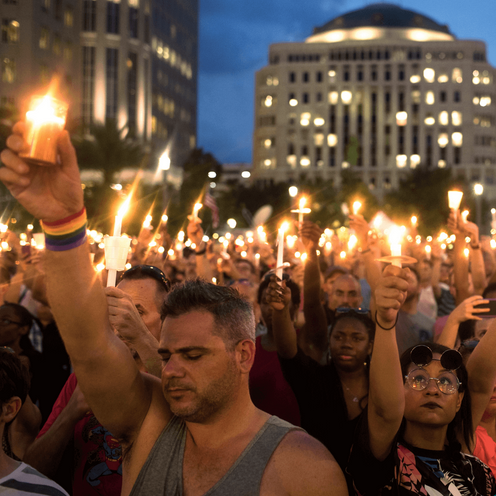

Source:
https://www.thetrevorproject.org/blog/remembering-
pulse-with-onepulse-foundation/
While LGBTQ people have had a high rate of non-affiliation, through their parades, holidays, and other rituals, the community has gradually shifted from a protest movement to a “civil religion” with transcendent elements, according to a study in the social science journal Society (online in April). Danish scholars Stefan Schwarzkopf, Sine Nørholm Just, and Jannick Friis Christensen, studying prominent observances and rituals like pride parades and marches, write that “they echo the religious rituals that can be found in the larger social environment that the LGBTQ+ movement is embedded in, including processions, exuberant carnivals, silent vigils and commemorative litanies.” Robert Bellah and other sociologists typically viewed the LGBTQ movement as a lifestyle enclave, but the authors argue that the whole range of rituals that the community now engages in beyond pride parades “connects their participants to a sphere of transcendent meaning.” Because the movement is said by its proponents to be about social action, the researchers refer to these shared religious practices as taking on the characteristics of a civil religion.
Schwarzkopf, Just, and Christensen write that the LGBTQ movement first adopted mainstream Christian rituals and “then symbolically connected them to new transcendent social aims and spheres, namely sacred sites, the commemoration of sacred events, the mourning of the dead, and the eschatological hope for the coming world without oppression.” Elements added more recently to the pride parades, such as the use of music, distinctive costumes, and objects such as the pride flag, have “taken the political character out of pride and replaced it with a religious one.” Critics have said that the pride events have largely been shaped by corporate sponsorship and the commercialization of earlier protests. But the researchers argue that these rituals have emerged spontaneously and “continue to be shape-shifting.” The importance of the “spirited assembly” in the form of the carnival, procession, and vigil, sacred sites (such as the Stonewall Inn, where the gay rights movement took form), and sacred objects (the AIDS quilt) all speak to the “power of the sacred” that is typical of religious rituals that “connect community members to transcendent experiences.” The authors conclude that “it remains to be seen how the movement’s liturgies will adapt to the now widely shared concern over the supposed mainstreaming and gentrification of LGBTQ+ activism.”
(Society, https://link.springer.com/journal/12115)